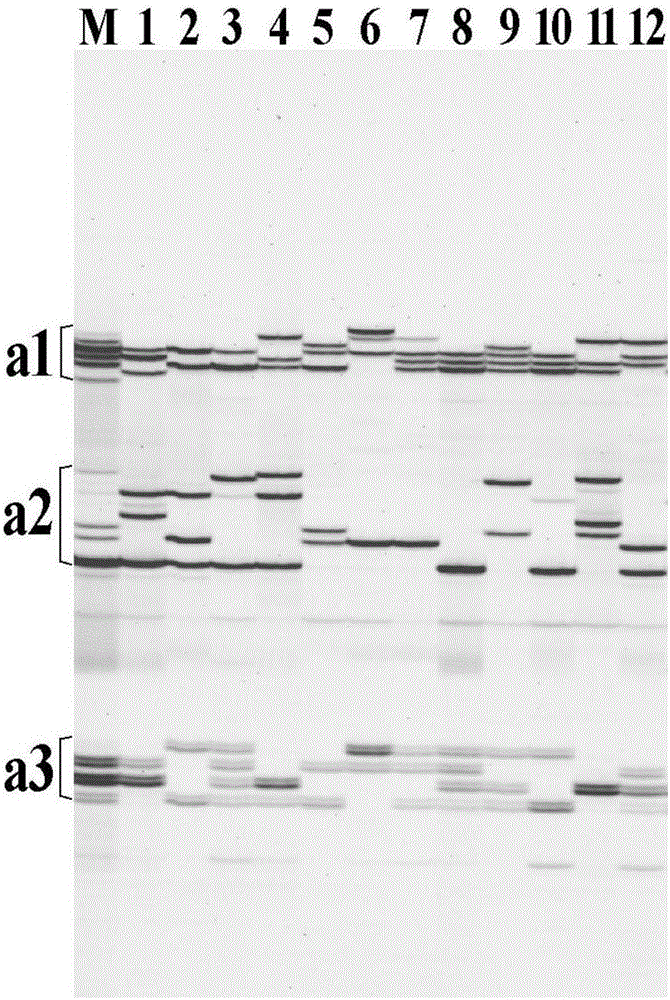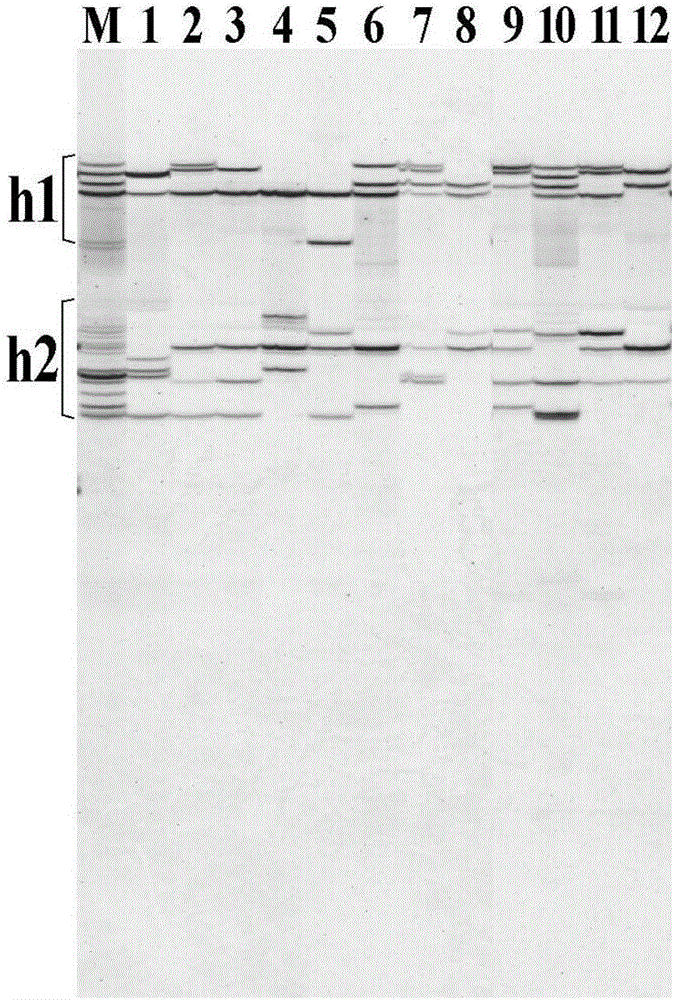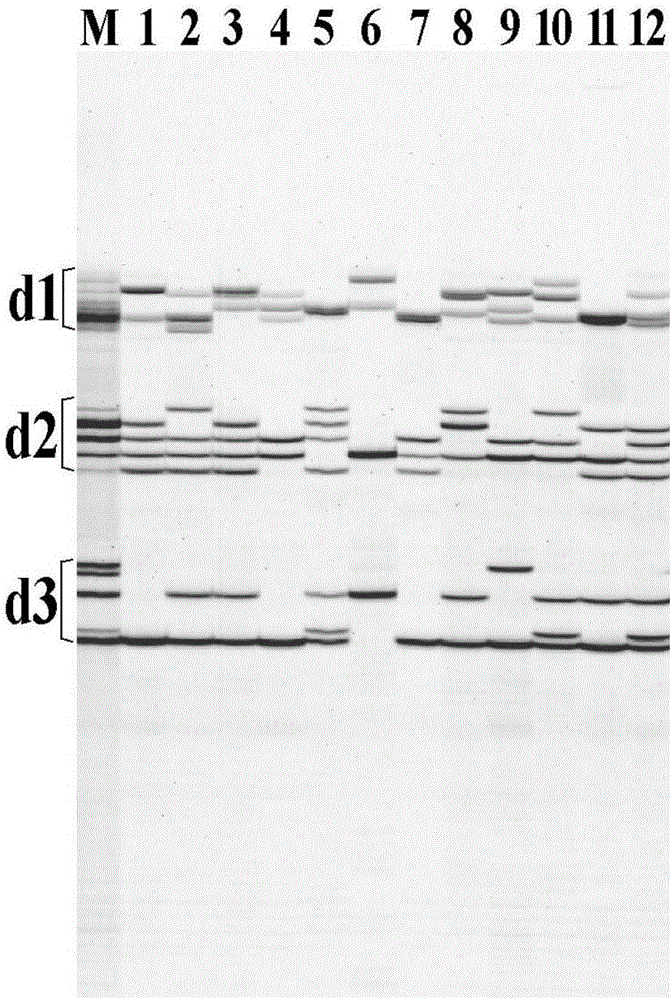Method for performing SSR analysis on tetraploid alfalfa by utilizing multiple PCR
A technology of alfalfa and tetraploid, which is applied in the direction of biochemical equipment and methods, microbiological determination/inspection, etc., can solve problems such as the genetic diversity analysis of tetraploid alfalfa that has not yet been seen, and achieve easy identification, uniform distribution, The effect of reading data quickly
- Summary
- Abstract
- Description
- Claims
- Application Information
AI Technical Summary
Problems solved by technology
Method used
Image
Examples
Embodiment 1
[0043] 1. Genomic DNA extraction and primer synthesis
[0044]Using alfalfa variety WL323 as the test material, 12 individual plants were randomly selected, enough young leaves were cut, and after freezing and grinding in liquid nitrogen, genomic DNA was extracted by the CTAB method of Doyle et al. Agarose gel electrophoresis detection of the quality and quantity of genomic DNA.
[0045] Synthesize group A primers BBI131F, GBG230 and E776153 according to the primer sequences in Table 1.
[0046] 2. Multiplex PCR
[0047] (1) The reaction system comprises the following components:
[0048] Template DNA 1.5ng / μL, Taq DNA polymerase 0.035U / μL, dNTPs 0.25mM, 1×PCR Buffer (containing 1.5mM MgCl2), the concentrations of primers BBI131F, GBG230 and E776153 were 0.145μM, 0.170μM and 0.135μM ( Forward and reverse primers have the same concentration), and make up to 15 μL with deionized water.
[0049] (2) Carry out PCR amplification according to the following steps:
[0050] Pre-d...
Embodiment 2
[0056] 1. Genomic DNA extraction and primer synthesis
[0057] Using the alfalfa variety Algonquin as the test material, 12 individual plants were randomly selected, a sufficient amount of young leaves were cut off, frozen and ground in liquid nitrogen, and the genomic DNA was extracted by the CTAB method of Doyle et al., with λDNA as the reference standard. 0.8% agarose gel was used to detect the quality and quantity of genomic DNA by electrophoresis.
[0058] According to the primer sequences in Table 1, primers CBF96 and GAW212 of group H were synthesized.
[0059] 2. Multiplex PCR
[0060] (1) The reaction system comprises the following components:
[0061] Template DNA 1.5ng / μL, Taq DNA polymerase 0.035U / μL, dNTPs 0.25mM, 1×PCR Buffer (containing 1.5mM MgCl2), primers CBF96 and GAW212 were 0.160μM and 0.140μM (forward and reverse primers have the same concentration) , make up to 15 μL with deionized water.
[0062] (2) Carry out PCR amplification according to the foll...
Embodiment 3
[0069] 1. Genomic DNA extraction and primer synthesis
[0070] Using alfalfa variety Zhonglu No. 1 as the test material, 12 individual plants were randomly selected, and enough young leaves were cut off, frozen and ground in liquid nitrogen, and the genomic DNA was extracted by the CTAB method of Doyle et al., with λDNA as the reference standard. The quality and quantity of genomic DNA were detected by electrophoresis using 0.8% agarose gel.
[0071] Synthesize group D primers GBF56, CAW306 and BBG28 according to the primer sequences in Table 1.
[0072] 2. Multiplex PCR
[0073] (1) The reaction system comprises the following components:
[0074] Template DNA 1.5ng / μL, Taq DNA polymerase 0.035U / μL, dNTPs 0.25mM, 1×PCR Buffer (containing 1.5mM MgCl2), primers GBF56, CAW306 and BBG28 were 0.285μM, 0.115μM and 0.125μM (positive and negative to the same concentration as the primers), make up to 15 μL with deionized water.
[0075] (2) Carry out PCR amplification according to ...
PUM
 Login to View More
Login to View More Abstract
Description
Claims
Application Information
 Login to View More
Login to View More - R&D
- Intellectual Property
- Life Sciences
- Materials
- Tech Scout
- Unparalleled Data Quality
- Higher Quality Content
- 60% Fewer Hallucinations
Browse by: Latest US Patents, China's latest patents, Technical Efficacy Thesaurus, Application Domain, Technology Topic, Popular Technical Reports.
© 2025 PatSnap. All rights reserved.Legal|Privacy policy|Modern Slavery Act Transparency Statement|Sitemap|About US| Contact US: help@patsnap.com



